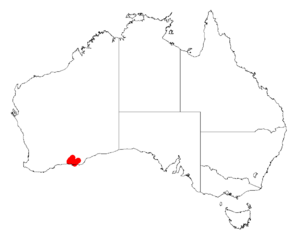Acacia euthyphylla facts for kids
Quick facts for kids Acacia euthyphylla |
|
|---|---|
| Conservation status | |
| Scientific classification | |
| Genus: |
Acacia
|
| Species: |
euthyphylla
|
 |
|
| Occurrence data from AVH | |
Acacia euthyphylla is a type of shrub, a small woody plant, that belongs to the large Acacia family. It is found only in Western Australia.
What it Looks Like
This shrub usually grows to be about 0.7 to 2.0 meters (2 to 6.5 feet) tall. It often has a rounded or funnel shape with many leaves. Its branches are smooth and have fine ribs. The leaves, called phyllodes, are light green and stand upright. They are straight or slightly curved, about 4 to 9 centimeters (1.6 to 3.5 inches) long and 2 to 3 millimeters (0.08 to 0.12 inches) wide, getting narrower at the bottom.
Acacia euthyphylla blooms between August and September. It produces bright yellow flowers. Each group of flowers has two clusters of round flower heads. These flower heads are about 4 to 5 millimeters (0.16 to 0.20 inches) across and contain 18 to 21 golden flowers. Later, the plant forms long, thin seed pods. These pods are about 6 centimeters (2.4 inches) long and 3.5 millimeters (0.14 inches) wide, holding seeds inside.
How it Got its Name
The plant was first officially described by a botanist named Bruce Maslin in 1999. He wrote about it in a scientific journal called Nuytsia. Later, in 2003, another botanist, Leslie Pedley, gave it a different name, Racosperma euthyphyllum. However, in 2006, it was moved back to the Acacia group, which is where it belongs today.
Where it Lives
Acacia euthyphylla is a special plant because it is endemic to a specific area. This means it only grows in a certain part of the world. For this plant, that area is along the south coast of the Goldfields-Esperance region in Western Australia. You can find it growing near salt lakes, marshes, and swampy areas that get wet during certain times of the year. It prefers sandy-clay-loam soils. This Acacia often grows among tall shrubs and in areas with mallee trees.


